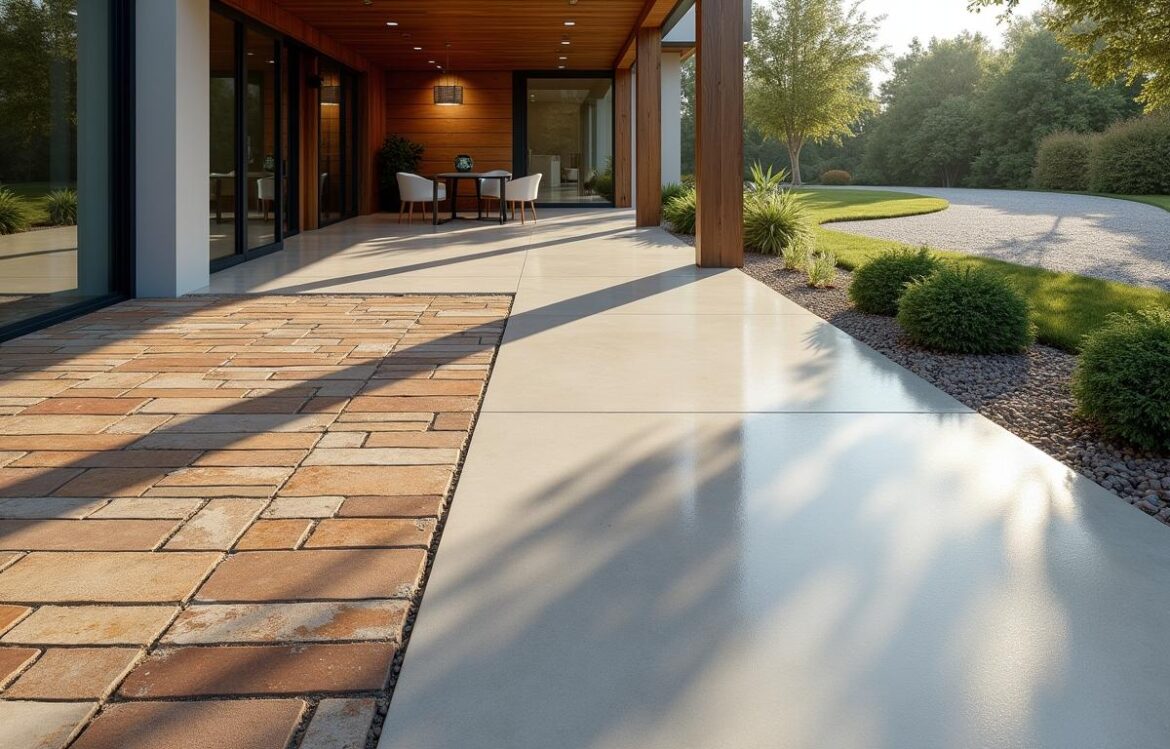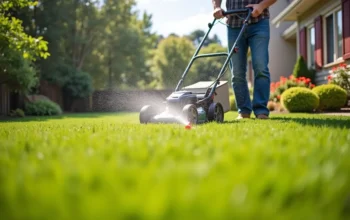
When selecting surfaces, consider concrete finish choices for both durability and appearance. The right selection goes beyond aesthetics, influencing slip-resistance, maintenance needs, and even environmental impact. Whether you’re planning a new patio, a stylish countertop, or a functional garage floor, there’s a finish tailored to every goal.
A few key factors guide any decision in this area. You’ll want to consider your local climate, your expected daily foot traffic, and the level of upkeep you can handle. From stamping and polishing to acid staining and decorative overlays, each approach offers its own flair.
Contents
- 1 Discovering stamped concrete for authentic patterns
- 2 Polished concrete and the allure of a sleek aesthetic
- 3 Embracing exposed aggregate for natural texture
- 4 Livening up surfaces with colored and acid-stained concrete
- 5 Granite finish, textured styles, and decorative overlays
- 6 Exploring sealer options for maximum protection
- 7 Industrial concrete finish and eco-friendly alternatives
- 8 Concrete pavers, slip-resistant features, and self-leveling solutions
Discovering stamped concrete for authentic patterns
Stamped concrete is an exciting technique that mimics high-end materials without the hefty cost. By using concrete stamping mats, installers create textures resembling stone, brick, or wood. The visual depth can enhance driveways, pool decks, and walkways with remarkable realism.
This style often pairs well with integral color, which is mixed directly into the concrete for a more consistent hue. Stamped concrete often goes by the name decorative concrete because it merges creative design with sturdy practicality. For maximum impact, choose a high-gloss concrete sealer or opt for a matte finish if you prefer subtle elegance.
Polished concrete and the allure of a sleek aesthetic
Polished concrete adds a sleek, modern feel to indoor floors, commercial spaces, and even residential living areas. Concrete polishing transforms a raw slab into a smooth surface by gradually grinding and buffing with specialized equipment. The end result can be a mirror-like gloss finish or a more understated matte finish concrete, depending on personal taste.
A polished look is popular in studios and showrooms because it reflects light, making spaces appear larger and brighter. Regular cleaning keeps polished floors vibrant, and a quick pass with a mop or gentle cleanser is often all it takes. Plus, you can pair the final surface with a concrete sealer for added durability.
Embracing exposed aggregate for natural texture
Exposed aggregate showcases the underlying stones or pebbles within the concrete, resulting in a distinctive, textured finish. Created by removing the top layer of paste before the slab fully hardens, these surfaces are excellent for slip-resistant finishes in driveways or courtyards. They blend well with surrounding landscaping to deliver a more organic vibe.
Exposed aggregate can be augmented with richer tones by using internal dyes known as integral color. This approach elevates the overall look and can complement both modern and rustic architecture. While the surface feels rugged, upkeep is fairly simple, often just requiring periodic resealing to prevent damage.
Livening up surfaces with colored and acid-stained concrete
Colored concrete brings endless possibilities. By adding pigments to fresh concrete, you can match an existing color scheme or introduce a bold accent. Meanwhile, acid-stained concrete creates variegated tones that become part of the material itself, making scratches less visible over time.
Acid staining involves chemical reactions that yield earthy hues, such as browns, greens, and terra-cottas, each with a unique, marbled character. Stained concrete suits patios perfectly, allowing for customized patterns that harmonize with outdoor furniture or greenery. When properly sealed with a top-quality concrete sealer, these surfaces resist fading and scuff marks.
Granite finish, textured styles, and decorative overlays
Granite finish refers to a method that mimics the look of natural stone using specialized aggregates and finishing techniques. This technique is ideal if you love granite’s timeless charm but want to maintain the practical benefits of concrete. You’ll typically see granite finish on countertops or floors where a touch of luxury is desired.
Textured concrete can also be achieved through broom finish or trowel finish methods, adding subtle grip and visual appeal. For an even more pronounced transformation, concrete overlays can go on top of existing slabs, solving issues like minor cracks or unevenness. These decorative finishes rejuvenate older surfaces without the cost and inconvenience of total replacement.
Considering concrete etching for personalization
Concrete etching is another artistic approach for creating intricate designs. Installers often use acid solutions or mechanical tools to carve patterns and reduce the surface, giving the floor a unique, hand-crafted appearance. This process is excellent for decorative concrete where specific shapes, logos, or borders are desired.
Etched designs can be combined with micro-toppings or colored dyes to accentuate edges and corner details. Should you decide to go bold with custom graphics, make sure you follow up with a protective coating or sealer. Doing so keeps artwork vibrant and guards against wear.
Exploring sealer options for maximum protection
Sealer options can make or break the lifespan of your concrete finishes. A high-quality concrete coating defends surfaces from moisture, stains, and abrasion. Polyurethane sealers offer durable, glossy protection, while acrylic-based sealers are easier to apply and often come in various sheen levels.
Epoxy coatings thrive in garages and industrial areas, thanks to their chemical resistance. They also pair nicely with decorative flake additives for a personalized touch. Whichever route you choose, remember that routine maintenance and occasional reapplication keep that fresh look going strong.
Achieving a durable gloss or matte finish
Your sealer choice affects more than just protection; it determines the visual style. For a bold statement in kitchens or showrooms, a gloss finish can amplify color and create a reflective feel. If you’re aiming for something more subdued, opt for a matte finish that absorbs light and keeps things understated.
The beauty of concrete finish options lies in their flexibility. From semi-gloss to satin and high-gloss concrete surfaces, you’re free to pick the level of shine that best suits your décor. Balancing style and function ultimately makes day-to-day use more enjoyable.
Industrial concrete finish and eco-friendly alternatives
Sometimes referred to as an industrial concrete finish, a more rugged aesthetic suits modern lofts or creative studio spaces. These floors typically highlight the raw texture of the concrete, accentuated with minimal polishing or a simple concrete paint. The result is a tough, edgy surface that fits well in urban settings.
If sustainability is top of mind, eco-friendly concrete solutions exist too. Using recycled aggregates, low-VOC coatings, and permeable finishes can reduce environmental impact. Concrete resurfacing also cuts down on waste by reviving existing slabs instead of pouring new ones from scratch.
Benefits of concrete resurfacing for worn-out slabs
Concrete resurfacing is a lifesaver if you notice cracks, spalling, or minor cosmetic flaws. A thin layer of cement-based material adheres to your existing slab, covering imperfections. This process typically pairs with decorative techniques like trowel finish or acid staining for a fresh façade.
Resurfacing transforms driveways, patios, or basement floors in a fraction of the time pouring new concrete would require. It’s also more cost-effective, especially for large spaces. Properly applied, a resurfacer extends the life of your slab and restores its original appeal without major construction.
Concrete pavers, slip-resistant features, and self-leveling solutions
Concrete pavers bring versatility to paths, walkways, and patios. Their uniformity makes them easy to install, and they can resemble brick, stone, or tile. Enhancing them with slip-resistant finishes is especially beneficial around pools and other wet environments, keeping friends and family safer.
For interior floors that need a flawless level base, self-leveling concrete is a game-changer. It spreads evenly to create a smooth canvas, and you can choose from matte finish or gloss finish topcoats. Trowel on a decorative layer or use acid staining for added personality. This straightforward approach also simplifies transitions between different rooms or flooring types.
Considering maintenance and final touches
Maintenance often comes down to sweeping, mopping, and periodic resealing. Even high-traffic areas can look pristine for years if you stay on top of cleaning routines. When issues arise, concrete coating or concrete paint can offer quick fixes, protecting your investment against further damage.
You can adopt slip-resistant additives for pool decks, upgrade your patio with integral color solutions, or incorporate subtle textures using concrete stamping techniques. The possibilities are limited only by your imagination. With thoughtful planning, each feature blends seamlessly for a result that stands out.
Selecting the right finish is all about balancing functionality with your personal style. Whether you’re drawn to a classic broom finish for safety or looking to jazz things up with decorative concrete overlays, there’s a method suited for every taste. True value emerges when appearance, durability, and easy upkeep align, making your space more inviting for years to come.



